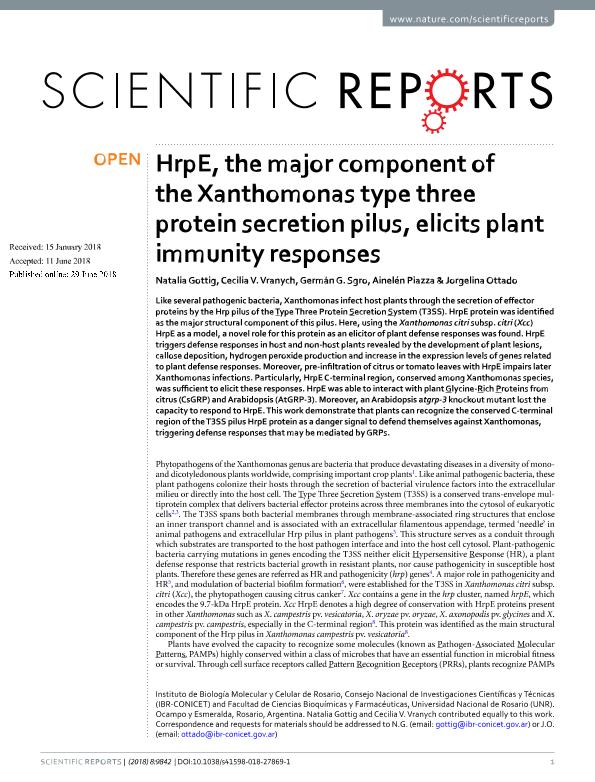Artículo
HrpE, the major component of the Xanthomonas type three protein secretion pilus, elicits plant immunity responses
Gottig Schor, Natalia ; Vranych, Cecilia Verónica
; Vranych, Cecilia Verónica ; Sgro, Germán Gustavo
; Sgro, Germán Gustavo ; Piazza, Ainelén Melanie
; Piazza, Ainelén Melanie ; Ottado, Jorgelina
; Ottado, Jorgelina
 ; Vranych, Cecilia Verónica
; Vranych, Cecilia Verónica ; Sgro, Germán Gustavo
; Sgro, Germán Gustavo ; Piazza, Ainelén Melanie
; Piazza, Ainelén Melanie ; Ottado, Jorgelina
; Ottado, Jorgelina
Fecha de publicación:
12/2018
Editorial:
Nature Publishing Group
Revista:
Scientific Reports
ISSN:
2045-2322
Idioma:
Inglés
Tipo de recurso:
Artículo publicado
Clasificación temática:
Resumen
Like several pathogenic bacteria, Xanthomonas infect host plants through the secretion of effector proteins by the Hrp pilus of the Type Three Protein Secretion System (T3SS). HrpE protein was identified as the major structural component of this pilus. Here, using the Xanthomonas citri subsp. citri (Xcc) HrpE as a model, a novel role for this protein as an elicitor of plant defense responses was found. HrpE triggers defense responses in host and non-host plants revealed by the development of plant lesions, callose deposition, hydrogen peroxide production and increase in the expression levels of genes related to plant defense responses. Moreover, pre-infiltration of citrus or tomato leaves with HrpE impairs later Xanthomonas infections. Particularly, HrpE C-Terminal region, conserved among Xanthomonas species, was sufficient to elicit these responses. HrpE was able to interact with plant Glycine-Rich Proteins from citrus (CsGRP) and Arabidopsis (AtGRP-3). Moreover, an Arabidopsis atgrp-3 knockout mutant lost the capacity to respond to HrpE. This work demonstrate that plants can recognize the conserved C-Terminal region of the T3SS pilus HrpE protein as a danger signal to defend themselves against Xanthomonas, triggering defense responses that may be mediated by GRPs.
Palabras clave:
Xanthomonas
Archivos asociados
Licencia
Identificadores
Colecciones
Articulos(IBR)
Articulos de INST.DE BIOLOGIA MOLECULAR Y CELULAR DE ROSARIO
Articulos de INST.DE BIOLOGIA MOLECULAR Y CELULAR DE ROSARIO
Citación
Gottig Schor, Natalia; Vranych, Cecilia Verónica; Sgro, Germán Gustavo; Piazza, Ainelén Melanie; Ottado, Jorgelina; HrpE, the major component of the Xanthomonas type three protein secretion pilus, elicits plant immunity responses; Nature Publishing Group; Scientific Reports; 8; 1; 12-2018; 1-13
Compartir
Altmétricas



